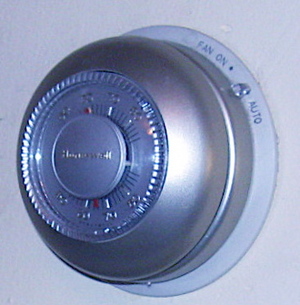You have two good reasons for installing a new home thermostat. The first is that the old one has simply stopped doing its job. A second reason is to save money on heating and cooling. A mechanical thermostat is easy to use and install, but it may not be the most efficient choice for your home. A modern digital electronic thermostat can deliver programmable temperature controls based on your family’s needs. Some low end electronic thermostats cost about the same as a good quality mechanical one. So, the choice is often just one of preference and need.
Having settled on a thermostat that you can operate that will control the temperature inside your home, the next step is to install it. Thermostat installation is not too difficult if you have a couple of medium sized screw drivers and about a half hour to do the job.
There is little chance of electric shock with a thermostat swap because thermostats operate at 10 to 15 volts. You should turn off the switch or breaker to your heating and air conditioning system. This is not really for your safety, but to prevent engaging the units by accidently touching wires together during the process. You could even risk sending a surge into some sensitive circuitry and damage your new thermostat or another circuit board in the system.
If you plan to relocate the thermostat to another part of the house, the job will become a little more involved. With that added in, you will want to be able to pull wires and may even need to buy all new wire and start at your furnace and work toward your new location. This is not really difficult work, but it can be a little tricky if you have to go into the attic or work in a crawl space.
To run new thermostat wire, you want to carefully remove the old wires one at a time at the furnace. Be cautious at this point to keep the color match the same from attachment to attachment. Run the new wire to the new location for the thermostat. When it is brought through the wall, just leave the wires hanging until you remove the old thermostat. If you did not have to relocate the thermostat, follow the directions from here to install the new unit. Pay close attention to the directions with the new thermostat in case there are specific differences that need to be noted.
Remove the cover from the old thermostat. Whether it is electronic or mechanical should not make a difference. Nearly all thermostats have a cover that just pops off. Once the cover is removed, you will see the colored wires attached to the screws inside the thermostat.
Make a note of how the color of the wire coating matches with the letter code by each terminal. Sometimes the thermostat wire will not have the precise color called for by the thermostat. The previous installer may have had to make a substitution or two. You will want to learn how it was done because you will need to do the new one the same way.
Once you have recorded the wire positions, unscrew them from the thermostat. You will see two to four screws that hold the unit to the wall. Remove these and pull the wire free from the old unit. Do not let the wires slip back into the wall.
Now, get the new unit and remove the front cover. Take time to look closely at the terminals and what wire colors are specified. Compare this to the list you made from the old thermostat. Slide the wires through the opening or openings in the thermostat and begin attaching them to the proper terminals. When the attachments are completed, you are ready to anchor the thermostat to the wall. If possible, let the new thermostat cover the entire area occupied by the old unit.
If the thermostat is a square or rectangle, use a level to get it positioned properly. With an electronic thermostat being level is not such a big deal for operation, but it looks much nicer on your wall if it is level. Before replacing the front cover, install batteries if they are required.
Some programmable thermostats require the cover to be off to access the programming mechanism. So, if you need to, take care of this before putting the cover onto the thermostat. You will want to consult the instruction manual for the proper way to program the new unit.
Set the temperature where you want it if you choose to not program the thermostat or if it a mechanical one. Turn it to heat or cool and test your work. Be careful in winter not to test your air conditioner. External temperatures below or near freezing can damage a compressor if it is started. If things come on correctly, you are finished. If not, you will need to do some checking on your connections.





